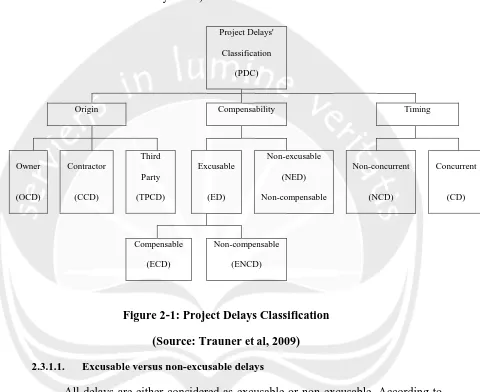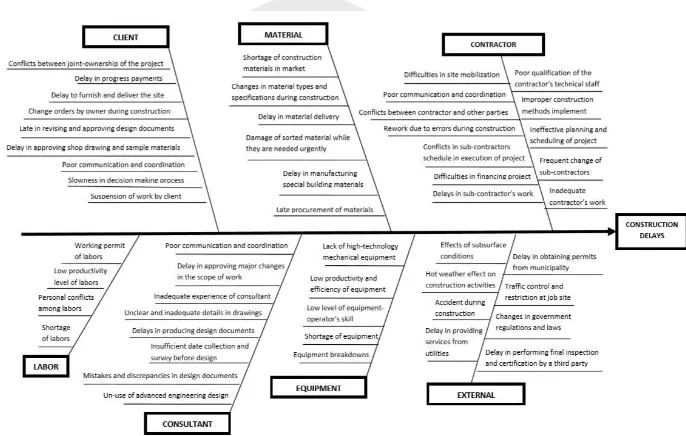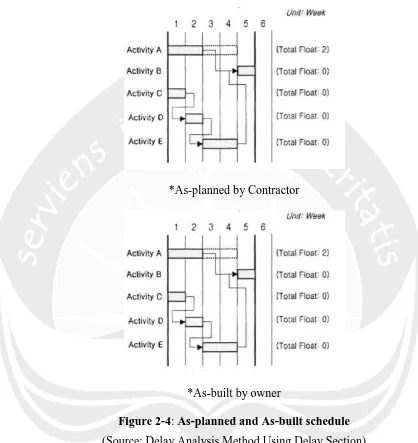6
CHAPTER
2.
LITERATURE REVIEW
2.1.Introduction
Many articles and studies conducted on causes of delay in construction projects have been reviewed either locally or internationally. To achieve this study few articles published during the last 20 years were reviewed concerning delays and time management used like.
The study Sugiharto Alwi and Keith Hampson (2006) showed that in Indonesia (Bali) there is no agreement between the two groups of contractors (small and large contractors). In their result, it stipulates that those contractors generally agree on the importance ranking of the individual delay variables. Recently contractors tried to overcome delay problems; the main reason is because the contractors have no ability to identify the important causes of delay occurring during the construction process.
2.2.Fundamentals of construction contracts
7
2.2.1.
Contractual RiskIn case there is no damage for delay, “Contractor‟s sole remedy for delay, loss of productivity, impact damages or other similar claims shall be an extension of time in which to complete the work. In no event in which to complete be entitle to additional compensation or damages for delay. The owner shall not be liable in monetary damages for the cost of delays which arise from acts or omissions for which the owner is responsible.
In case of Limited delay damages the contractor shall be entitled to an increase in the General Conditions if the Contractor‟s General Condition has actually been increased as a result of a delay to the critical path of the Project Schedule caused by the improper acts or omissions of the Owner.
Finally in case of Delay Damages, “In the event that Contractor's performance is delayed or hindered , through no fault of its own Contractor through no fault of its own, Contractor shall be entitled an extension of time corresponding to the number of days its performance was delayed, and shall be entitled to additional costs related to such delay or hindrance."
2.2.2. Extension of time
8
analyzed, either in terms of methodologies or in dealing with such factors as float and concurrency.
Adding to that if the Contractor is delayed at any time in the commencement or progress of the work by an act or neglect of the Owner or Architect, or of an employee of either, or a separate contractor employed by the owner, or by changes ordered in the work, or by labor disputes, fire, unusual delay in deliveries, unavoidable causalities or other causes beyond the Contractor‟s control, or by delay authorized by the Owner pending mediation and arbitration, or by other causes which the Architect determines may justify delay, them the Contract Time shall be extended by Change Order for such reasonable time as the Architect may determine.
2.3.Construction schedule delays
The task of investigating the events that led to project delay for the purpose of determining the financial responsibilities of the contracting parties arising from the delay is called “delay analysis” or DA.
2.3.1. Types of delays
9
Delays / ED and Non-Excusable Delays / NED), and timing (Non-Concurrent Delays / NCD and Concurrent Delays / CD).
Project Delays'
All delays are either considered as excusable or non-excusable. According to Callahan et al. (1992) and Trauner et al. (2009), it depends on the clauses in the contract. Excusable Delays are further subdivided into two categories. They are Non-Compensable Delays and Non-Compensable Delays.
10
floods, acts of god, owner-directed changes, errors and omissions in the plans and specifications, differing site conditions or concealed conditions, unusually severe weather, intervention by outside agencies, lack of action by government bodies (building inspection). In addition to that, Levy (2006) adds two more excusable delays to the above list as illness or death of one or more of the contractors, transportation delays over which the contractor has no control. In another study, Kelleher (2005) added two more conditions which are epidemics, quarantine restrictions.
Non-excusable delays are events that are within the contractor‟s control or that are foreseeable. Mubarak (2005) defines non-excusable delays as “delays that are either caused by the contractor or not caused by the contractor but should have been foreseen by the contractor”. Furthermore Trauner et al. (2009) point out some examples which are late performance of sub-contractors, untimely performance by suppliers, faulty workmanship by the contractor or sub-contractors, a project-specific labor strike caused by either the contractor‟s unwillingness to meet with labor
representative or by unfair labor practices. Moreover Mubarak (2005) added some more examples as Contractor cash-flow problems, accidents on the site caused by the contractor‟s negligence or lack of preparations, late delivery of the contractor‟s
furnished materials and equipment.
11
would be entitled to a time extension and possibly if the contractor would be entitled to compensation for that time extension.
CONTROL WITHIN CONTRACTOR CONTROL
12 2.3.1.2. Critical versus Non-critical delays
Several studies classify delays only into three groups as Excusable and Non-excusable, Compensable and Non-compensable and Concurrent and Non-concurrent. Therefore certain authors (Trauner et al., 2009; Callahan et al., 1992) added one more category which is critical and Non-critical delays.
According to them, delays that affect the project completion, or in some cases a milestone date, are considered as critical delays, and delays that do not affect the project completion, or a milestone date, are noncritical delays.
Trauner et al. (2009) also notified that the issue of critical delays emerges from the Critical Path Method (CPM) scheduling. The determining which activities truly control the project completion date depends on the following criteria which are the project itself, the contractor‟s plan and schedule (particularly the critical path), the requirement of the contract for sequence and phasing, the physical constraint of the project.
2.3.1.3. Compensable versus Non-compensable Delays
According to Callahan (1992), an excusable delay can be classified either “excusable compensable” or “excusable non-compensable”. Some studies notified
Non-13
Compensable Delay is for unusually severe weather. That is weather which is not anticipated at that time of year in that part of the country.
On one hand "Non-compensable delays" are excusable delays which are actual delays to the project schedule but are within the parties' contemplation and not the fault of either the contractor or the owner. These include delays caused by unusual weather, other acts of God, and even some forms of labor disputes. Essentially, these types are beyond the control of the parties and, therefore, will neither be compensated nor penalized to any particular party to the construction project. Although the contractor is not entitled to extra compensation for non-compensable delays, in most instances it is entitled to an extension of contract time.
"Compensable delays," on the other hand, are excusable delays to the construction schedule which are allegedly within the control of the parties and are caused by the fault of one party or the other or even a combination of forces. In these instances, the parties to the contract undoubtedly have incurred cost impacts to their extended performance due to an extended period of time that the project covers.
2.3.1.4. Concurrent delays
According to Callahan et al. (1992) too concurrent delay is “more than one delay contributed to the project delay, not that the delays necessarily occurred at the same time”. Mubarak (2005) states that a concurrent delay includes a combination of
14
Furthermore Mark Boe, P.E. stated in the Capital Project Management, Inc that concurrent delay occurs when a contractor and an owner have both caused independent critical path delays — delays that affect the completion date of a project — during the same approximate time period. Consequently, barring a contract
provision to the contrary, neither can recover damages without a clear allocation of each party‟s delay and expense.
Concurrent delay refers to the complex situation where more than one event occurs at the same time, but where not all of those events enable the contractor to claim an extension of time or to claim loss and expense.
2.3.2. Causes of delay
The result of the study of Alwi and Keith Hampson (2003) concerning the main causes of delay in Indonesia is poor design, user changes, weather, site conditions, late deliveries, economic conditions and increases in quantity. In addition to that, Hampson et al. (2001) stated that destructive conflict resolution leads to additional costs and delays to a project.
Also Chan and Kumaraswamy (1997) found that the five principal and common factors of delays to be poor risk management and supervision, unforeseen site conditions, slow decision making involving all project teams, client-initiated variations, and necessary variations of works.
15
management, inadequate contractor experience, inadequate client‟s finance and
payments for completed work, problem with subcontractors, shortage in material, labor supply, equipment availability and failure, lack of communication between parties and mistakes during the construction stage.
According to Sugiharto Alwi and Keith Hampson the delay factors were divided into six (6) major groups which are People, Professional Management, Design and Documentation, Materials, Execution and External. Their research stipulates that the main causes of delay are poor design, user changes, weather, site conditions, late deliveries, economic conditions and increases in quality.
Kaming et al. (2006) studied influencing factors on 31 high-rise projects in Indonesia and found out that cost overruns occur more frequently and are more severe problem than time overruns. They stated the majors factors influencing cost overrun are material cost increase due to inflation, inaccurate material estimation and degree of complexity.
- 16 -
- 17 - 2.3.3. Effects of delays in construction
Gene Wortham has presented in his study that construction delays has for effects acceleration, schedule change or inefficiency, delayed project completion, missed intermediate completion dates, liquidated damages, frustrations of the parties (claims) and last but not the least increased costs of the projects.
In the research about the problems of projects and effects of delays in the construction industry of Pakistan, 2011, it stipules that mostly delay problems are cause of dispute, negotiation, lawsuit, total desertion, litigation and abandonment. The parties included in contract through claims agree on the additional capital and extra time linked with construction delay. The general consequences are the loss of wealth, time and capacity. For owner, delay means the loss of income and unavailability of facilities. For contractor, delay means the loss of money for extra spending on equipment and materials and hiring the labor and loss of time.
- 18 -
2.4.Methods of Delay Analysis
To identify delays and to measure the effects on a construction projects, it is primordial to use the appropriated methods. In delays construction, bar charts and Critical Path Method are the basic tools to identifying them. To make sure that the agreed construction duration is done on time, a planned schedule should be given by the contractor. With that they will maintain and upload any changes on the project (unexpected conditions). A basic premise of schedule delay analysis is that delay is measured from the project‟s completion rather than from any interim activity date
(Bramble and Callahan 2002). When a schedule delays occurs, the planned and as-built schedules are the basic data source for delay analysis (Bubshait and Cunningham, 1998).The main idea is that the as-planned versus as-built method compares two schedules, which is why it is also called “the total time method or net impact method”. The hypothesis is that the contractor is not responsible of the delay
and the owner causes all delays.
In the theory of Nguyen (2007), the method displays the net impact of all claimed delays on project‟s finish date. There are three kinds of activity in as-built schedules
- 19 -
*As-planned by Contractor
*As-built by owner
Figure 2-4: As-planned and As-built schedule
(Source: Delay Analysis Method Using Delay Section)
2.5.Planning sequences in construction industry
- 20 -
interactions among the different work tasks. A good construction plan is the basis for developing the budget and the schedule for work.
2.6.Methods of minimizing construction delays
Based on several studies of project success factors and rectification of delays in construction project, several recommendations were given to all parties. First owners should pay progress payment to the contractor on time, minimize change orders during construction to avoid delays, avoid delay in reviewing and approving of design documents than they anticipated, and check for resources and capabilities, before awarding the contract to the lowest bidder (Assaf. and Al-Hejji, 2006).



